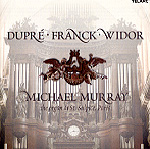Other than a human voice, no instrument has more individuality than the organ, and none has nearly the multitude of combinations and permutations of colors and timbres. Add to that the more or less immutable physical and acoustical features of the organ’s location, and you have quite a challenging mix of variables and constants, whether you’re trying to play the thing or just trying to capture a reasonable sonic likeness on a recording. Paris’ Saint-Sulpice church is truly a magnificent structure, the space inside second in size only to the same city’s more famous Notre Dame cathedral. The five-manual Cavaillé-Coll instrument that resides there–one of the great masterpieces of organ-building, constructed in 1862–contains 102 stops and is among the largest pipe organs in the world.
If you can’t make it to Paris and you want to hear what this instrument sounds like, this recording comes about as close as such things can to give you a sense not only of the organ’s huge range of colors and dynamic power but also of the acoustic space itself. The organ is put through its paces by one of today’s more illustrious soloists–a formidable technician, an imaginative colorist, and an outstanding musical interpreter. A student of Marcel Dupré, Michael Murray demonstrates this wonderful instrument’s wide expressive possibilities in some of the more ostentatious, atmospheric, harmonically and texturally rich French repertoire from three of the organ’s greatest composers (two of whom, Dupré and Widor, served at Saint-Sulpice).
From the disc’s opening explosion of color–Dupré’s Magnificat VI: Gloria–through the same composer’s bold Choral et Fugue and dreamy Antiphon III, to the two “symphonic” works by Franck and Widor, we’re impressed by the strength of the instrument’s lower-register stops, the brilliance of its upper winds and reeds, and the lovely warmth of the strings and flutes. Some listeners may feel that the sound is just a little too bright in spots–and slightly more distant than ideal. But there are countless tricky logistical considerations when recording any organ, and we can only assume that veteran engineer Mike Hatch chose the optimal location for his microphones. My only real reservations about this disc concern the “busyness” and weightiness of the program: there’s so much going on in these pieces that sensory overload is a likely possibility if you try to listen to this all in one sitting. One other thing’s for sure: if you keep your volume turned up, your sound system will be in for a wild ride.
































